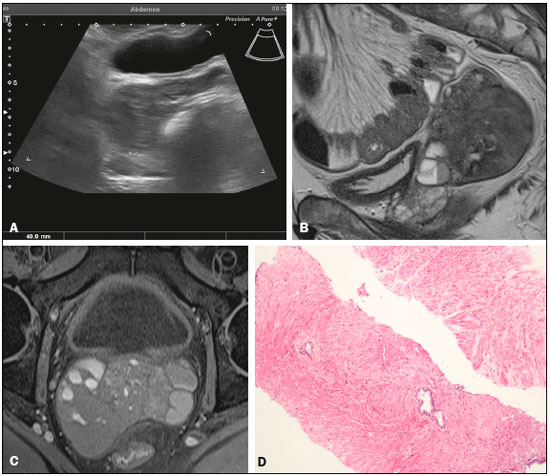Sr. Editor,
Paciente masculino, 60 anos, deu entrada no ambulatório da urologia com lesão expansiva detectada por toque retal. Relatava ressecção transuretral da próstata, tabagismo e etilismo. Negava sintomas consumptivos e referentes ao trato urinário. A ultrassonografia pélvica transabdominal mostrou próstata heterogênea, de contornos e peso normais (Figura 1A). Vesículas seminais aumentadas à custa de lesão sólida bem definida e heterogênea. Ressonância magnética (RM) demonstrou lesão expansiva sólido-cística na vesícula seminal direita, bem definida, sinal intermediário em T1, hipossinal em T2 e nível líquido-líquido no plano sagital. Sem realce pós-contraste ou restrição à difusão, estendia-se para a vesícula seminal contralateral e mantinha plano de clivagem com estruturas adjacentes (Figuras 1B e 1C). Estes achados levantaram a possibilidade de um nódulo benigno, mantendo o raciocínio utilizado para as lesões ovarianas e renais(1,2). Foi realizada biópsia transretal ecoguiada, e o estudo histopatológico revelou abundante músculo liso maduro, benigno e escasso epitélio colunar biestratificado, compatível com leiomioma de vesícula seminal (Figura 1D). Para diferenciá-lo de outros tumores estromais, como o leiomiossarcoma e o tumor epitelial estromal misto, realizou-se estudo imuno-histoquímico, que demonstrou falta de expressão do marcador da proteína nuclear expressa (Ki-67) e negatividade para receptores de estrógeno, progesterona e antígeno prostático específico.
 Figura 1. A:
Figura 1. A: Ultrassonografia pélvica transabdominal demonstrando lesão hipoecogênica sólida, de limites definidos, localizada na loja da vesícula seminal direita, medindo 4,0 cm.
B: RM, sagital T2, demonstrando lesão expansiva de limites definidos, heterogênea, com predomínio de componente de baixo sinal. Há ainda nível líquido-líquido.
C: RM, axial T1 fat
suppression, demonstrando lesão sólida com epicentro na vesícula seminal direita, heterogênea, com maior componente de isossinal.
D: Lâmina histológica mostrando abundante músculo liso maduro, benigno, e escasso epitélio colunar biestratificado.
Tumores geniturinários têm sido relatados, recentemente, na literatura radiológica nacional
(2-7). O leiomioma é um tumor benigno de músculo liso encontrado no útero e no trato gastrintestinal. Apesar da alta incidência no trato genital feminino, são incomuns no trato geniturinário masculino, sendo raros os casos relatados na literatura
(8). Podem se proliferar em qualquer tecido composto de músculo liso, separado por variáveis quantidades de tecido conjuntivo. Segundo autores, sua origem advém dos ductos mesonéfricos e paramesonéfricos, sendo a diferenciação imuno-histoquímica ainda controversa
(9).
As vesículas seminais são glândulas extraperitoniais do sistema reprodutor masculino que secretam fluido contendo enzimas
(10). As alterações mais comuns das vesículas seminais são agenesia e anomalias císticas. Neoplasias primárias são extremamente raras e incluem leiomioma, cistoadenoma, angioendotelioma, teratoma, schwannoma e paraganglioma
(9,10). Os pacientes com leiomioma de vesícula seminal frequentemente são assintomáticos, podendo ocorrer dor lombar, polaciúria, disúria, dor perineal e infertilidade
(11).
As lesões epiteliais são mais frequentes, representadas por neoplasias secundárias como o carcinoma da próstata, bexiga, reto e adenocarcinoma primário. Achados típicos na RM incluem lesões com hipossinal em T2, obliteração dos tecidos adjacentes e perda da arquitetura normal das vesículas seminais. Já as afecções estromais têm composição sólido-cística e sinal variável
(12).
Os paragangliomas extra-adrenais, que são tumores neuroendócrinos raros, se apresentam como lesão definida com hipersinal em T2 e realce pós-contraste, podendo ser heterogêneos com áreas necróticas. Nos schwannomas há hipersinal em T2 e intenso realce pós-contraste. Já os cistoadenomas se apresentam como massa cística multiloculada, bem definida, geralmente unilateral com hiperintensidade em T2 e discreto realce
(9,10,13,14).
As lesões sólidas das vesículas seminais são muito raras e com características de imagem pouco específicas, entretanto, podemos nos basear nos parâmetros diagnósticos já bem comprovados de outras lesões sólidas abdominais, como as ovarianas e renais, como linha de raciocínio para suspeita de benignidade.
REFERÊNCIAS1. D''Ippolito G, Lima ACM, Peddi Neto L, et al. Neoplasias sólidas de ovário: análise sistematizada e ensaio iconográfico. Rev Imagem. 2006; 28:165-70.
2. Sousa CSM, Viana IL, Miranda CLVM, et al. Hemangioma of the urinary bladder: an atypical location. Radiol Bras. 2017;50:271-2.
3. Leapman MS, Wang ZJ, Behr SC, et al. Impact of the integration of proton magnetic resonance imaging spectroscopy to PI-RADS 2 for prediction of high grade and high stage prostate cancer. Radiol Bras. 2017;50:299-307.
4. Fernandes AM, Paim BV, Vidal APA, et al. Pheochromocytoma of the urinary bladder. Radiol Bras. 2017;50:199-200.
5. Espindola APBP, Amorim VB, Koch HA, et al. Atypical presentation of mature cystic teratoma ("floating balls"). Radiol Bras. 2017;50:206-7.
6. Lima LLA, Parente RCM, Maestá I, et al. Clinical and radiological correlations in patients with gestational trophoblastic disease. Radiol Bras. 2016;49:241-50.
7. Manikkavasakar S, Ramachandram A, Ramalho M, et al. Malignant uterine disease with concurrent miometrial contraction at MRI: a possible source of overstaging. Radiol Bras. 2016;49:342-3.
8. Arnold SJ, Lin FC, Eldersveld JM, et al. Seminal vesicle leiomyoma mimicking extra-prostatic extension of prostatic adenocarcinoma. Urol Case Rep. 2016;6:18-20.
9. Shaikh AS, Bakhshi GD, Khan AS, et al. Leiomyoma of the seminal vesicle: a rare case. Clin Pract. 2013;3:e32.
10. Reddy MN, Verma S. Lesions of the seminal vesicles and their MRI characteristics. J Clin Imaging Sci. 2014;4:61.
11. Shiotani T, Kawai N, Sato M, et al. Leiomyoma of the seminal vesicle. Jpn J Radiol. 2009;27:218-20.
12. Kim B, Kawashima A, Ryu JA, et al. Imaging of the seminal vesicle and vas deferens. Radiographics. 2009;29:1105-21.
13. Dagur G, Warren K, Suh Y, et al. Detecting diseases of neglected seminal vesicles using imaging modalities: a review of current literature. Int J Reprod Biomed (Yazd). 2016;14:293-302.
14. Zhu JG, Chen WH, Xu SX, et al. Cystadenoma in a seminal vesicle is cured by laparoscopic ablation. Asian J Androl. 2013;15:697-8.
1. Universidade Federal do Triângulo Mineiro (UFTM), Uberaba, MG, Brasil
2. Hospital das Clínicas da Universidade Federal do Triângulo Mineiro (UFTM), Uberaba, MG, Brasil
Endereço para correspondência:Dr. Dimitrius Nikolaos Jaconi Stamoulis
Hospital das Clínicas - UFTM. Avenida Getúlio Guaritá, 130, Nossa Senhora da Abadia
Uberaba, MG, Brasil, 38025-440
E-mail:
dimitriusss@hotmail.com

 |
|

